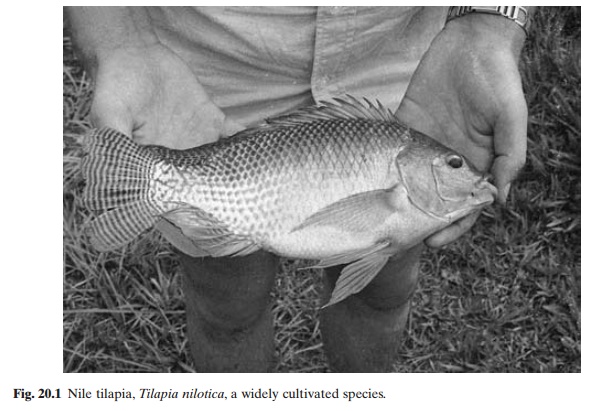Chapter: Aquaculture Principles and Practices: Tilapias
Cultivated species of tilapias
Cultivated species of tilapias
Thys (1969) described at least 77 species (besides a number of
sub-species) of Tilapia, and Jhingran
and Gopalakrishnan (1974) listed 22 species that have been used in experimental
or production-scale fish culture. Considerable confusion exists on the
taxonomic status of many of them. Because of the overlap of morphological
characteristics, taxonomists have tried to split the genus of Tilapia largely according to breeding
behaviour, which coincides roughly with macrophytophagous, micro-phagous and
omnivorous feeding habits. The substrate spawners, which make nests on the
bottom of water bodies and spawn in them, retained the name Tilapia and the mouth-brooders, which
incubate the fertilized eggs in the mouth of the female or male parent, came
under a new genus Sarotherodon
(meaning ‘brush toothed’) (Trewavas, 1982). Later, a new genus, Oreochromis, was constructed to
accommodate species which spawn in nests on the bottom of water bodies but
brood the eggs in the mother’s mouth. Though in most cases Tilapia spp. have coarse teeth and feed onmacrophytes, Sarotherodon spp. have fine teeth and
feed on unicellular and filamentous algae. The feeding habits are, however, highly
flexible and are not a strong diagnostic characteristic. Recently, two
alternative classifications were proposed. One includes five genera: Tilapia,
Sarotherodon, Oreochromis, Tristromella and Danakilia. The other contains only one genus, Tilapia, with seven sub-genera:
Heterotilapia, Pelmatilapia, Sarotherodon, Oreochromis, Nya-salapia, Alcolapia and Neotilapia (Fishelsonand Yaron, 1983). These revisions of the
classification have not eliminated the confusion, and other taxonomists prefer
the continued use of the broad genus Tilapia
for all the species. As aquaculturists may find it difficult to keep up with
the frequently changing nomenclature.
For commercial aquaculture, the more important species of tilapia are: T. rendalli, T. zillii, T.
mossambica, T. hornorum, T. nilot-ica (fig.
20.1), T. aurea and T. melanotheron.

Two other species, T. andersonii and T. spilurus, also seem to
be of some importance. It is believed that very few pure strains of these
species are used in fish farms, and natural cross-breeding has occurred in many
areas. As will be discussed later in this section, inter-specific hybrids
including red-coloured hybrids have been cultured commercially on a limited
scale.
Though essentially a tropical species which cannot survive temperatures
below 10°C, tilapias have been introduced for commercial culture in
sub-tropical areas and even in temperate areas for indoor culture under
controlled temperature conditions.
Related Topics